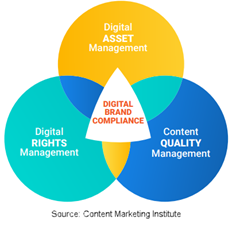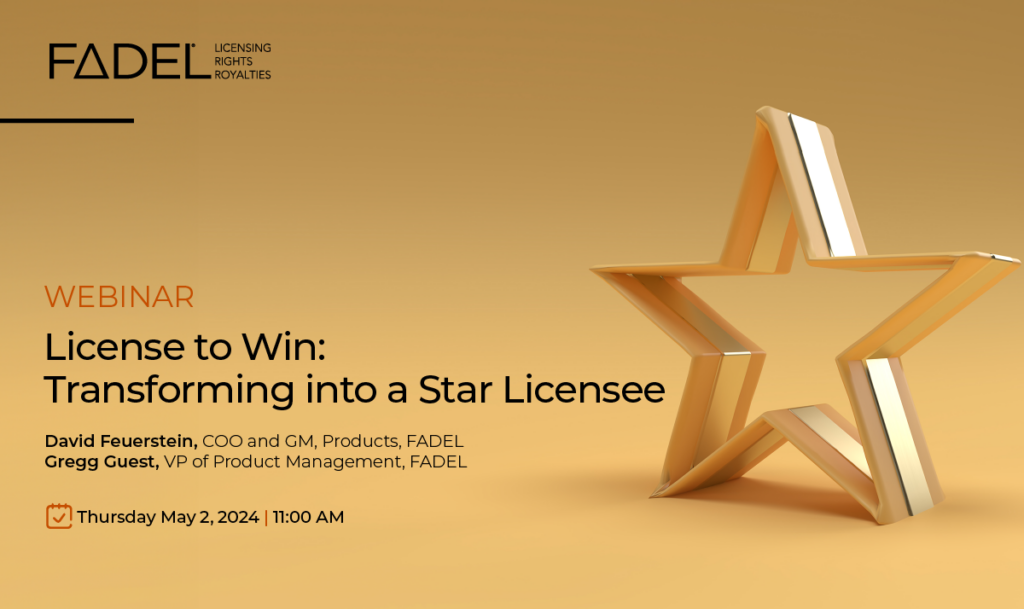
Digital Brand Compliance: A Content Marketing Concern Across Industries

Not long ago, organizing and scaling digital assets was considered a challenge that only traditional media outlets had to strategically solve. Think of the pre-internet players: newspapers, magazines, TV, radio, and billboards. Although these companies archived their content, repurposing and reuse was less of a priority, as channels were quite limited. Fast forward to the age of 24-hour feeds via digital forms of all of these outlets, plus hundreds more cable channels, over-the-top media, banner ads, social media, apps, and the advent of multi-channel marketing—and content management becomes a lot more important.
Many of these new media channels, particularly web and social, are now accessible to all, bringing content management to the forefront for product and service businesses of all types.
Today, your traditional media companies are not the only ones with the need to archive, organize, manage, and repurpose digital marketing media assets. Content marketing has become a key component of a successful marketing strategy across industries and most of today’s companies use numerous digital channels to communicate with their customers. According to a 2017 study by Aberdeen Strategy & Research, 51% of companies used at least eight digital channels to interact with customers. By 2022, that percentage has surely grown.
Like traditional media companies 30 years ago, today’s product and services companies must approach media management with a strategic mindset.
Managing media when you’re not a media company
New media channels have made content king for marketing and brand management strategies across every industry. Digital content influences consumers at every stage of the marketing funnel, from awareness to consideration, conversion, loyalty, and advocacy. That means that creative agencies need to create, distribute, and manage a lot of digital media assets, and their efficiency, effectiveness, and innovation in doing so will dictate how far their marketing budgets get them.
A new realm for advertising agencies
 As digital content increases exponentially, ad agencies need to efficiently manage the assets of each brand they represent, carefully tracking rights, being aware of not only the content but the restrictions of owned media, and knowing what, where, and when assets can be repurposed. Knowing how to make the most of a customer’s budget is key to customer retention.
As digital content increases exponentially, ad agencies need to efficiently manage the assets of each brand they represent, carefully tracking rights, being aware of not only the content but the restrictions of owned media, and knowing what, where, and when assets can be repurposed. Knowing how to make the most of a customer’s budget is key to customer retention.
According to MarTech Series, the top challenges digital marketing agencies face are:
- Adoption of new technology
- Increasing data security concerns
- Changing the approach to content
- Increased competition
Some of the increased competition is now coming from the brands themselves, who are choosing to bring creative in-house. Adopting the latest media management technology with enterprise-class data security will give customers the confidence that their agency partners are on top of their game, allowing them to focus on their core business instead of adding yet another strategic initiative to their already overtaxed teams.
A trend toward bringing marketing & advertising content in-house
To get the most of their budgets and accelerate time-to-market, companies ranging in size from startups to multinationals are choosing to manage media with in-house creative agencies. According to a study by the Association of National Advertisers (ANA), 78% of members had some form of in-house agency in 2018, compared to 58% in 2013 and 42% in 2008. Why the shift?
- Multi-channel marketing has become a near necessity for a successful marketing strategy and it demands an abundance and variety of digital content.
- Technological advancements from design and production applications to smart phones have made it possible for practically anyone to create digital content at a significantly lower cost than outsourcing to traditional ad agencies.
- Cloud solutions have created economies of scale that give companies of all sizes access to the enterprise-class digital asset management capabilities required to manage the sheer volume of digital assets being generated, along with the ability to scale to meet their storage and access needs in the future.
Does bringing your creative agency in-house make financial and strategic sense?
Cost savings and efficiencies can be gained by bringing content in-house, however it isn’t as straightforward as it may seem on the surface. It’s important to lay the foundation for your creative team. First of all, the generation of digital assets has become a practical free-for-all, muddying waters for brand usage rights and standards and creating assets that may not even land in a company’s internal repository. Consider a few examples:
- Consumer-generated content, e.g., product unboxing videos posted to social media.
- Streaming videos or podcasts that are generated both internally and in tandem with third parties.
- Brand ambassador images or videos that should comply with the brand image and standards.
Furthermore, the digital assets that fuel every marketing campaign must be created, organized, purposed, and repurposed across media channels with a careful eye toward usage rights, restrictions, copyright regulations, and licensing agreements. Digital Rights Management is one key service that should be considered foundational for any in-house agency.
New challenges for content marketers
Due to the proliferation of digital assets, the responsibilities of content marketers have been extended beyond the traditional definition of brand compliance, i.e., that elements presented across channels and geographies align with brand guidelines. The increased breadth of content, content types, and channels in which to use them has resulted in the expanse of “brand compliance” to encompass more complex digital activities, including:
 Content services to store, enrich, search across, and share brand assets, including images, audio, video, and interactive applications with stakeholders.
Content services to store, enrich, search across, and share brand assets, including images, audio, video, and interactive applications with stakeholders.- Digital rights management to ensure that the reuse and repurposing of content complies with usage rights, copyright regulations, and licensing agreements.
- Content tracking to locate brand assets being used on the web, report on violations of terms and expiration dates, and identify trends to inform content strategy.
- Brand monitoring across third-party channels to keep tabs on quality, for example how brand ambassadors are representing the brand by detecting brand assets.
Thus, the notion of brand compliance has broadened to “digital brand compliance,” which the Content Marketing Institute (CMI) defines as a solution that helps orchestrate and automate the complexities of digital media assets’ legal, usage, compliance, and custom brand standards across a multi-channel ecosystem. In order to accomplish this, companies need a comprehensive media management operation.
FADEL addresses this market requirement with Brand Vision – an integrated, cloud-based platform for brand compliance and monitoring. It allows marketing teams to easily organize content, keep track of rights, and track brand assets web-wide.

The birth of a new and growing market: Digital Brand Compliance
 According to Robert Rose, Founder and Chief Strategy Officer of The Content Advisory, the education and consulting group for CMI, a comprehensive media management operation calls for the capability to manage brand compliance. There are three systems that are essential for successful media management: digital asset management systems, digital rights management systems, and content quality management systems. These three systems come together to accomplish the common goal of Digital Brand Compliance, and each has their own unique—and ever-evolving—purpose.
According to Robert Rose, Founder and Chief Strategy Officer of The Content Advisory, the education and consulting group for CMI, a comprehensive media management operation calls for the capability to manage brand compliance. There are three systems that are essential for successful media management: digital asset management systems, digital rights management systems, and content quality management systems. These three systems come together to accomplish the common goal of Digital Brand Compliance, and each has their own unique—and ever-evolving—purpose.
Digital Asset Management (DAM) Systems
In the early days, DAM systems were simply digital asset repositories that enabled teams to store content and organize it for easier retrieval. Today, DAM systems are used for real-time engagement, giving rise to cloud-based solutions.
Digital Rights Management Systems
Initially intended to protect digital media from being copied, distributed, or accessed by unauthorized parties, digital rights systems have evolved to include compliance with more nuanced requirements, such as usage rights, copyright regulations, regional availability, and licensing agreements. The need for real-time maintenance and validation has also made cloud-based solutions a more popular choice.
Content Quality Management Systems
The next generation is emerging with advanced functionality that monitors rich media assets, i.e., video, audio, and applications, against content-usage standards, such as violations, expirations, and royalties.
The key to a successful brand compliance strategy is integrating these systems and functions. Linking asset rights and terms of use when assets are captured and organized within your DAM system will not only save considerable time, it will allow you to maximize the value of your investments while minimizing the risk of misuse. In this way, you can focus on the long game rather than firefighting problems that arise due to siloed systems.
Looking toward the future

Managing media when you’re not a media company has become a pervasive challenge, yet absolutely essential to maximizing both marketing budgets and the ROI of brand investment. The ubiquitous need for digital brand compliance will cause the market to grow at a projected compound annual growth rate of 18% over the next five years (CMI), enticing more and more software vendors to enter the market. However, first-mover advantage gives vendors that are already in the brand management and compliance space the ability to focus on innovation and enhancements rather than the basics, giving customers more value—and expertise—for their money. While every company may not consider themselves a media company (yet), many are already adopting operations to control and monitor the growing volume of media they need to manage.
A digital brand compliance checklist
 A digital brand compliance suite should provide at-a-glance insight into managing your brand assets, visibility into what content is used where and how, and whether that is allowed. Some things to look for include:
A digital brand compliance suite should provide at-a-glance insight into managing your brand assets, visibility into what content is used where and how, and whether that is allowed. Some things to look for include:
- Scalable, cloud-based services with an intuitive user interface
- Basic ability to store, enrich, organize, and share digital assets
- Ability to capture extensive metadata including custom data, rights, and standardized information
- Powerful searchability and sharing of assets using sophisticated search tools and interactions with external constituents
- Internal and external asset monitoring and management (think of content created by influencers, executives, marketing, sales, customer service, and customers)
- Hierarchical access for different user types including creative agencies, internal departments, and affiliates/influencers
- Role-based, purpose-driven tools designed for different roles that acquire, manage, enrich, consume, or view assets
- A collaborative digital asset environment that supports the project workflow
- Ability to monitor usage of assets across the content lifecycle
- Tracking digital marketing content usage on social media and web
- Brand monitoring of products, logos, spokespersons, and media content for in-licensing
- Dashboard insights into usage rights, copyright regulations, and licensing agreements
- Real-time notification of violations and upcoming expiration dates










